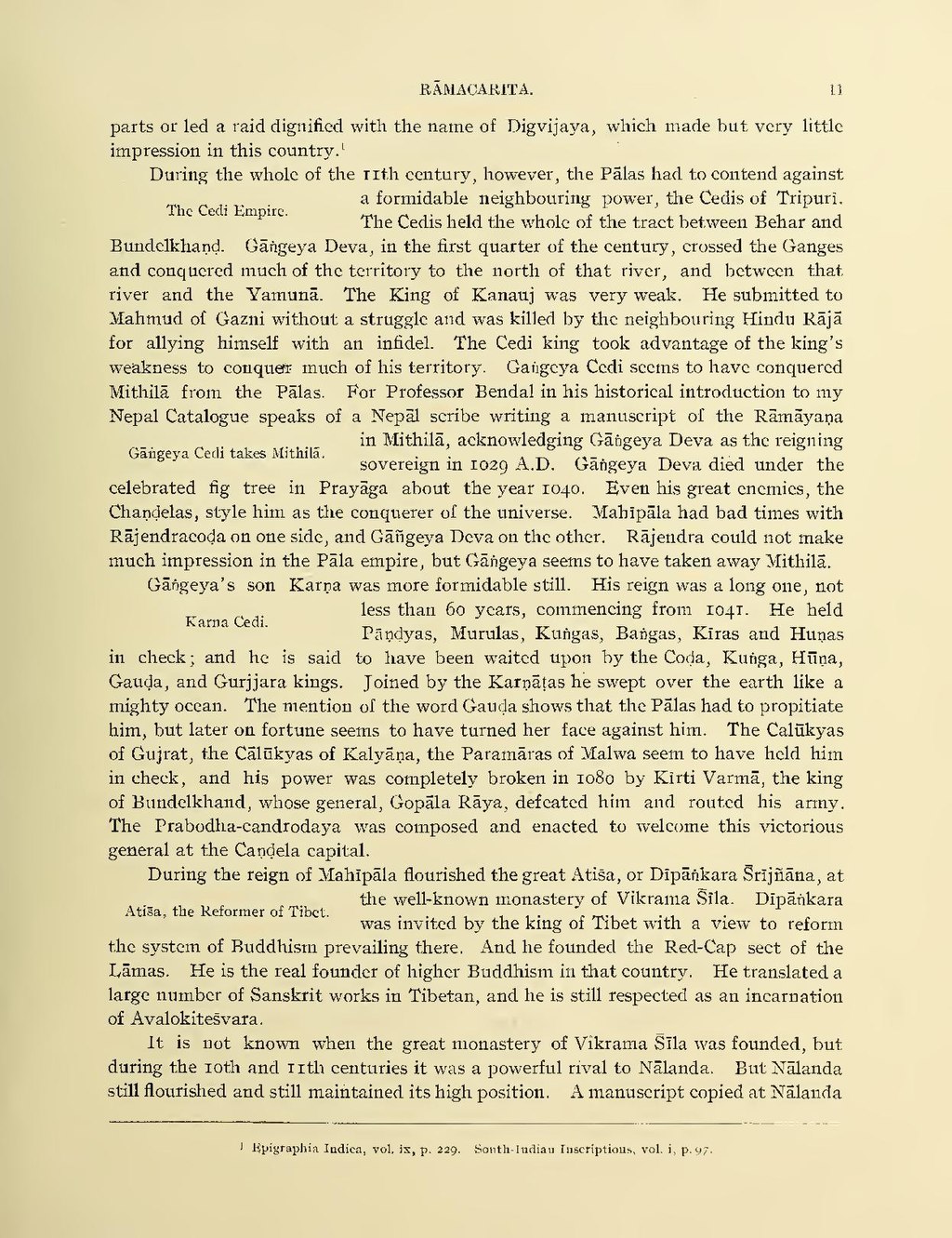RĀMACARITA. parts or led a raid dignified with the name of Digvijaya, which made but very little impression in this country. The Cedi Empire. During the whole of the 11th century, however, the Palas had to contend against a formidable neighbouring power, the Cedis of Tripuri. The Cedis held the whole of the tract between Behar and Bundelkhand. Gangeya Deva, in the first quarter of the century, crossed the Ganges and conquered much of the territory to the north of that river, and between that river and the Yamunā. The King of Kanauj was very weak. He submitted to Mahmud of Gazni without a struggle and was killed by the neighbouring Hindu Rājā for allying himself with an infidel. The Cedi king took advantage of the king's weakness to conquer much of his territory. Gangeya Cedi seems to have conquered Mithila from the Palas. For Professor Bendal in his historical introduction to my Nepal Catalogue speaks of a Nepal scribe writing a manuscript of the Ramayana in Mithila, acknowledging Gangeya Deva as the reigning Gangeya Cedi takes Mithila. sovereign in 1029 A.D. Gangeya Deva died under the celebrated fig tree in Prayaga about the year 1040. Even his great enemics, the Chandelas, style him as the conquerer of the universe. Mahipāla had bad times with Rajendracoda on one side, and Gangeya Deva on the other. Rajendra could not make much impression in the Pala empire, but Gangeya seems to have taken away Mithila. Gangeya's son Karpa was more formidable still. His reign was a long one, not Karna Cedi. less than 60 years, commencing from 1041. He held Pandyas, Murulas, Kungas, Bangas, Kiras and Hunas in check; and he is said to have been waited upon by the Coda, Kunga, Hupa, Gauda, and Gurjjara kings. Joined by the Karpațas he swept over the earth like a mighty ocean. The mention of the word Gauda shows that the Palas had to propitiate him, but later on fortune seems to have turned her face against him. The Calūkyas of Gujrat, the Calūkyas of Kalyāṇa, the Paramāras of Malwa seem to have held him in check, and his power was completely broken in 1080 by Kirti Varma, the king of Bundelkhand, whose general, Gopāla Raya, defcated him and routed his army. The Prabodha-candrodaya was composed and enacted to welcome this victorious general at the Candela capital. Atisa, the Reformer of Tibet. During the reign of Mahipala flourished the great Atiša, or Dipānkara Srijñāna, at the well-known monastery of Vikrama Šila. Dipankara was invited by the king of Tibet with a view to reform the system of Buddhism prevailing there. And he founded the Red-Cap sect of the Lāmas. He is the real founder of higher Buddhism in that country. He translated a large number of Sanskrit works in Tibetan, and he is still respected as an incarnation of Avalokitesvara. [] It is not known when the great monastery of Vikrama Sila was founded, but during the 10th and 11th centuries it was a powerful rival to Nalanda. But Nalanda still flourished and still maintained its high position. A manuscript copied at Nalanda Epigraphia Indica, vol, ix, p. 229. Sonth-Indian Inscriptions, vol. i, p. 97.

